Scalp reduction surgery is a medical procedure that entails the surgical removal of portions of bald skin in an attempt to reduce its size. It can be performed by itself or in conjunction with hair transplantation where hair follicle grafts are then inserted to fill in the reduced region of hair loss. Scalp reduction surgery is also referred to as alopecia reduction (AR) surgery, galeoplasty (GR), male pattern baldness reduction (MPB) or baldness reduction surgery.
General Method of Baldness Reduction
Scalp reduction is performed in the doctor’s office using local anesthesia. Reducing bald areas of the scalp is accomplished by excising and removing areas of skin at the top part of the balding crown. The surrounding regions of hair growth are then pulled upwards as the remaining edges are stitched together. In rare cases, this may be enough to completely eradicate signs of baldness. In most instances when the patient has adequate quantities of remaining hair, a hair transplant procedure is performed to transfer donor follicles to fill in the bald area that has been reduced in size. The pattern of scalp excision varies from any one of the following diagrammatic depictions:
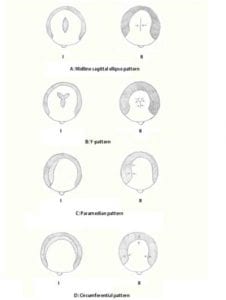
When Is A Scalp Reduction Surgery Performed?
This outdated and outmoded hair restoration method used to be considered when a patient does not have enough head donor hair to fully achieve their goals. The thinking then was that by reducing the area of the bald region, the available donor hair supply on the scalp could then offer a greater extent of coverage through a hair transplant procedure.
Baldness reduction surgery is performed to help reverse the appearance of hair loss that results from either androgenic alopecia (male pattern baldness) or cicatricial alopecia, a condition where the immune system attacks the hair follicles.
In certain situations, scalp reduction was used to enhance the effects of a surgical brow lift to tighten the forehead and reduce the appearance of wrinkles, frown lines and crows feet.
Scalp reduction has been used in accident patients, burn victims and individuals with certain types of congenital birth defects.
Warnings Against Baldness Reduction Procedures
Scalp reduction is a highly invasive and risky procedure. The general medical community has issued public warnings against this approach. WebMD even included it on their list, Hair Loss Procedures to Avoid.
The Risks of Scalp Reduction Surgery
Baldness reduction procedures may seem viable in theory. But in actual reality, cosmetic complications are likely to arise. Patients not only regret choosing this type of procedure but also have to face additional surgeries to repair the mistakes that resulted from their scalp reduction.
Crown Slot Formation
>As the hair continues to shed around the areas where edges of the scalp were pulled together, unnatural patterns of baldness emerge. A typical sign of a scalp reduction gone wrong is the formation of a vertical area of hair loss that looks like a slot in the crown area.
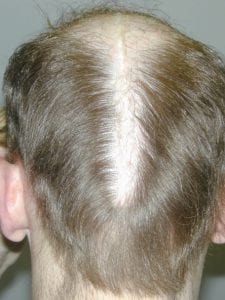
Decreased Donor Density
Pulling the scalp upwards stretches the skin in the surrounding areas of hair growth. As a result, this reduces the hair density in these regions. When this occurs, patients would not be able to benefit from hair transplantation following the scalp reduction procedure. Harvesting donor grafts would only cause more of the scalp to become visible.
Additional Scalp Reduction Risks
Besides crown slot formation and decreased donor density, the two most known risks of scalp reduction surgery, there are various other complications that may arise:
- The skin around the stitched edges may stretch in a direction opposite of the scalp pulling, creating a renewed form of baldness
- Occipital nerve damage from the excisions may create a loss of sensation known as hypoesthesia.
- Pulling the scalp upward may drastically elevate the peri-auricular hairline and the temporal recesses, creating an abnormal appearance around the ears
- Infections may develop at the excision sites
- Skin tissue may suffer from a lack of oxygen or blood as a result of severing or disrupting normal blood supplies.
- Shock loss due to follicles reacting to the trauma from the excisions. Hair may thin or fall out temporarily or permanently
- Hair grows in unnatural directions as a result of pulling different sides of the scalp together
- The scalp may lose its tightness after the surgery causing a “stretch back” effect, expanding the scalp and creating visible areas of baldness. This occurs in nearly 100% of all procedure cases, according to Web MD, creating what is known as a dog-eared scar
- Blood may pool as a result of damaging the blood vessels, causing the patient to suffer from hematoma as well as hemorrhaging
- The patient’s body may reject the sutures created in deep layers of the skin, creating holes where the stitches were placed. Also, the sutures may cause swelling and pain.
- Large and highly visible scars may develop when the sutures pull the skin too tightly.
Here is an example of a patient who had undergone a scalp reduction surgery, among several other hair restoration procedures. Elevating the periauricular areas distorted the normal projection of how his ears were projected.

The formation of a crown slot distorts the original spiral-shaped hair whorl pattern. Scalp reduction patients are left with hair that grows in unnatural directions, as a result of pulling the different sides of the scalp together. Here is a photo of a patient showing the complete loss of the spiral-shaped hair whorl pattern that is normally seen in the crown.

When the sutures of a scalp reduction procedure pull the skin too tightly, the scalp tries to restore its normal laxity and equilibrium by stretching. This “stretch back” tendency widens the linear scar tissue that remains after closing the edges of the scalp together. Due to the excision pattern created from scalp reduction surgery, this creates a dog-eared shape. Here is a patient photo that illustrates this.
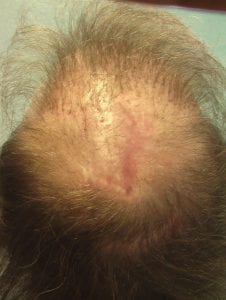
Removing the upper section of the scalp and pulling the remaining edges back together can raise the posterior hair neckline to unusually high levels, yet another form of permanent deformity resulting from baldness reduction procedures.

To learn more about how to repair signs of damage from scalp reduction, with the help of body hair to head transplantation, sign up for a complimentary consultation with Dr. U
Repairing Damage from Male Pattern Baldness Reduction Surgery
Continued hair loss is very likely to occur following baldness reduction procedures. As the skin on the scalp is likely to stretch and expand, the scar tissue formed from these surgeries may expand and become more noticeable.
Scalp reduction deformities and baldness are permanent. The only way to cosmetically resolve these issues is by concealing them through the transplantation of an abundant hair supply.
In most cases, patients will not have enough head donor hair remaining to adequately cover the mistakes from their scalp reduction procedures. Currently, head sources are the only option offered by standard hair restoration clinics. This is because they only have the tools and expertise to extract grafts from this area.
Therefore, if the objective is to repair past surgery mistakes, it would be necessary to harvest additional reserves of hair restoration grafts from other parts of the body. Since they can only come from the same individual, this leaves body hair as the only way to expand donor resources in order to repair the negative consequences of alopecia reduction surgery.
Hair that grows outside the head requires specially designed extraction tools, largely due to the varying angles at which they grow. General Follicular Unit Extraction hair transplant punches work well for safely removing straight scalp hair which emerges almost perpendicular to the skin’s surface. However, their cylindrical barrel-shaped design poses the risk of damaging body hair follicles.
Dr. Umar conceived and engineered his highly advanced Dr.UGraft technology where the sharp edge of the punch curves away from the follicle as it turns. A relatively shallow incision is needed, replacing the need to precisely enclose the entire follicle within the punch in order to separate it from the surrounding tissue.
The design of the Dr.UGraft rotary punch (i.e. Dr.UPunch Rotor ™) enables all types of hair follicles from the head and body to be safely removed without incurring the typical forms of mechanical damage that tend to occur with regular Follicular Unit Extraction punches.
The Dr.UGraft technology also uses a water irrigation system to protect grafts from air exposure which is the leading cause of follicular death in hair transplant procedures.
Keeping grafts healthy, whole, and protected improves their chances of surviving long term in the recipient areas so that they can grow new hair and produce the coverage needed.
Before and After Photos – Scalp Reduction Repair Using Body Hair Grafts
This patient’s crown slot formation could not be concealed using head hair alone. His only hope of restoring a normal appearance was to utilize grafts taken from other regions of his body. Since the patient’s beard hair was thick, wavy, and grew in large quantities, this made an excellent match for covering the widening area of hair loss.
Dr.Umar harvested a donor supply of 3000 grafts from the patient’s beard area to cover the slot formation and blend naturally with the rest of the hair.
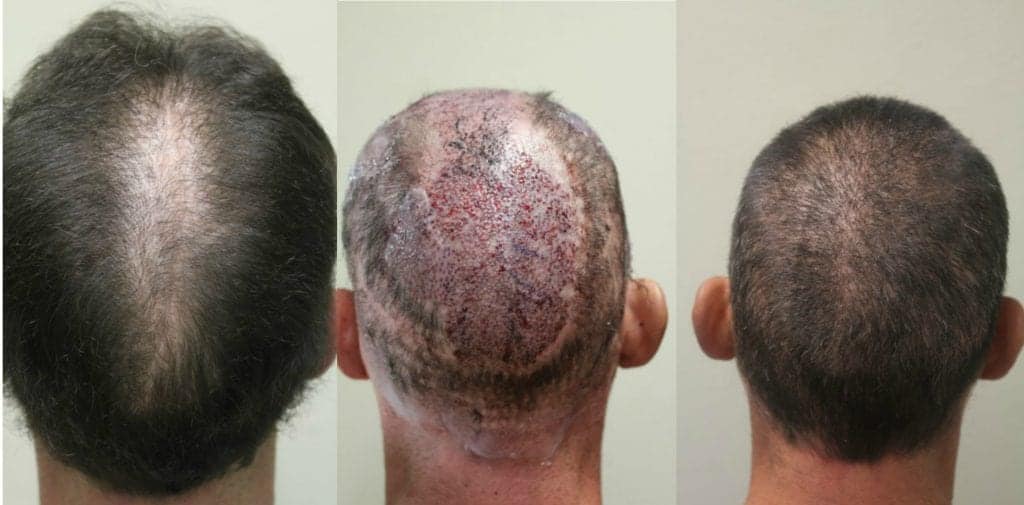
Likewise, the following patients were able to achieve immensely successful repair results of their scalp reduction deformities, including stretch back dog ear scarring, distorted hair growth directions, raised periauricular hairline, and elevated neckline. The feat of covering these mistakes was considered hopeless by conventional hair transplant standards due to the depleted supply of head donor hair. Through the use of the highly specialized advanced FUE technology developed by Dr. Umar, the Dr.UPunch intelligent ™, it was possible to harvest enough grafts from body sources to achieve the coverage seen in the photos below.
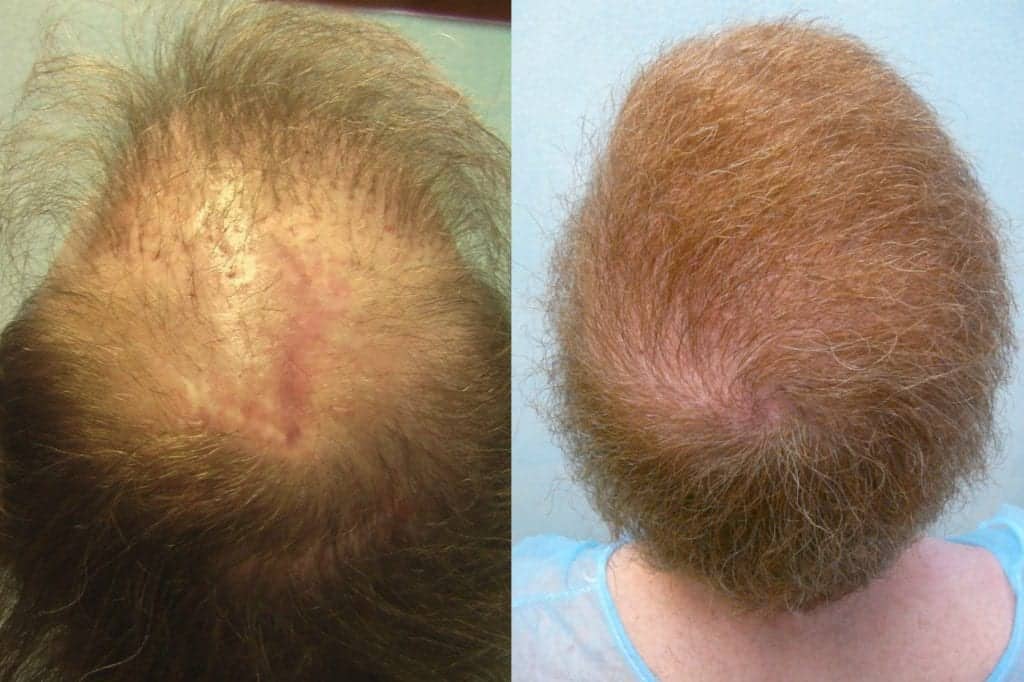
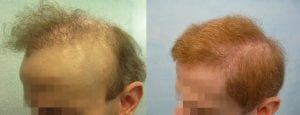

No Title
Many people, (like the patient shown here) mistakenly think that hair transplantation is a simple, straightforward process, transferring follicles from one area to another. However, there are numerous details to consider for the whole picture. And when overlooked, results can be disastrous, requiring additional and expensive repair procedures to fix these errors.
Did Donald Trump Undergo a Scalp Reduction Procedure?

The popular media culture has kept its eye on Donald Trump and his comb-over hairstyle for many years, even long before his presidency. His oddly shaped low hairline caused many to speculate that he wears a toupee.
However, in a 1990 divorce deposition, his now ex-wife, Ivanna Trump described under oath a domestic violence incident that resulted from the pain Trump was experiencing as a result of his scalp reduction procedure.
A Trump biography, Lost Tycoon, The Many Lives of Donald Trump, by Harry Hurt III included the information from this deposition along with alleged accounts by the doctors who performed the procedure. According to Hurt, Trump was suffering from “nagging headaches caused by the shrinking of the scalp, and the pain of the initial incision.”
In past years, scalp reduction offered the approach of maximizing the extent of coverage from a limited head donor supply by reducing the surface area of thinning or baldness. The available follicles on the scalp can then be inserted at a much higher density in a smaller area of hair loss.
With this strategy, however, the scalp becomes permanently deformed. And this oftentimes contributes to poor cosmetic outcomes that others easily notice.
Today, it is certainly possible to overcome the challenges of a low quantity of head donor resources without having to resort to an invasive and extremely painful scalp reduction surgery. This can be achieved by acquiring a large number of additional grafts from other areas of the body where hair grows abundantly. Since the anatomy of hair growth on the body is different from the head, specialized designed surgical tools like the Dr.UPunch Rotor intelligent™ are an absolute necessity for ensuring healthy, robust donor follicles that can survive long-term in the recipient area to produce the expected growth.
The Dr.UPunch Rotor intelligent™ is an advanced FUE rotary punch that cuts away from the hair follicle and requires a more shallow incision into the skin to separate the graft from its surroundings. Compared to a generally straight, cylinder FUE punch, this design can remove any type of hair, regardless of its growth angle. Additionally also uses water irrigation to protect the newly extracted grafts from air drying which compromises their survivability.
To learn more about undergoing procedures using the Dr.UPunch Rotor intelligent™ for scalp reduction repairs, or achieving the best possible coverage with a low head donor supply, schedule a free consultation to discuss your goals with Dr. Umar.
Frequently Asked Questions – Scalp Reduction Surgery
Are there any procedures that can correct the actual deformities to the scalp caused by Baldness Reduction Surgery?
Baldness reduction surgery is a highly invasive procedure. The scars that are created are permanent. Furthermore, in this type of procedure surgeons actually removes bald sections of the scalp. This cannot be reversed. Since the effects of scalp reduction surgery are permanent, the only way to repair the effects of baldness reduction surgery is to conceal the scarring and misshaped areas of the scalp. This can be accomplished by acquiring the necessary quantity of grafts needed to cover the scalp so that the aftermath of baldness reduction surgery is no longer noticeable.
Since Alopecia Reduction Surgery results in scalp deformities and may incur many types of complications, why is there still a market for this type of procedure?
Alopecia reduction surgery is still being supported by some physicians who assert that this is a low-risk procedure that can benefit the right patient cases. Furthermore, the demand for alopecia reduction procedures stems from the need to achieve the best form of coverage when the number of head donor grafts are limited. While the use of body hair grafts can achieve extensive coverage to meet the aims of the patient, this approach is still considered new and in the beginning stages of gaining greater awareness among physicians and the patients who can benefit from them.
What explains the strange-looking hairline seen on Donald Trump if he did undergo scalp reduction surgery?
Scalp reduction surgery may result in varying forms of deformities on the head. While it is difficult to explain the appearance of Donald Trump’s hair, it is quite possible that his hairstyle is intended to conceal scarring and possible malformities which may have been caused by scalp reduction surgery. Others postulate that Trump may have had a flap surgery instead. In this procedure, a strip is fashioned from the hair-bearing side of the scalp by excising it on three sides and leaving the fourth side attached to the head. Surgeons then twist the flap at this juncture in order to wrap it around the forehead and create an instant hairline. This may explain why Trump’s hairline sits so low on his forehead. Because Trump’s biography cites the term scalp reduction, used in Ivanna Trump’s deposition, many people believe that scalp reduction is the more likely procedure responsible for his hair.
If a hair transplant patient does not have enough donor grafts, and they are discouraged from having a scalp reduction procedure, then what other option do they have?
It is possible for men who suffer from pattern baldness and do not have enough donor grafts left on their heads to acquire additional grafts from other parts of the body. However, hair from these areas would need to be thick and long enough to serve as hair transplant grafts that could be used to provide the right type of coverage.
Have more questions about scalp reduction surgery? Use the button below to ask Dr. Umar.
Further Reading
Find out what to look for in a hair transplant clinic.
Learn about how Dr.UGraft allows for body hair transplant procedures.
See how Dr. Umar repairs depleted donor situations with Dr.UGraft.


